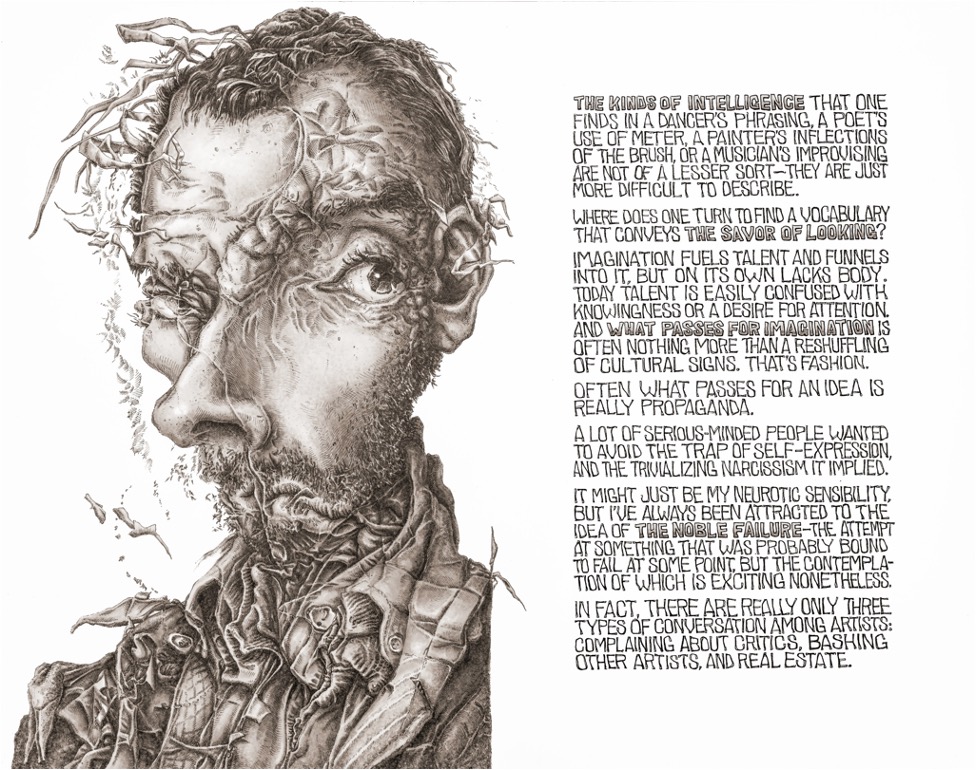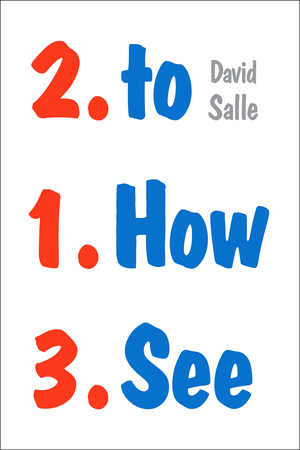Looking, Talking, and Thinking about Art
David Salle
Originally published by W.W. Norton & Company (2016)
This review is part of A Look Back, a series across Rain Taxi’s print and online editions that reflects on older books that continue to resonate.
Art writing has been a problem in the art world for decades. Beyond criticism, even the didactic texts posted on gallery and museum walls are so routinely convoluted that the style of writing has become known as “International Art English.” The art writing of David Salle, however, lands differently, not because it’s anti-institutional—he’s a darling of the institution—but because he simply refuses to let the art he’s passionate about fall prey to dissertation-ese. Take this description from the tribute to his former teacher John Baldessari:
It speaks to the amazingly resilient desire to make art, which is to say, to forge unlikely connections between things, to access unexpected emotional currents, to make poetry, to make a new meaning or at least shake off the old one.
Salle’s contagious enthusiasm and commitment to plain language make his How to See a pleasure to read. None of the essays in this collection wade into solipsistic debates about what is and isn’t art (have designations like non-objectivism or post-structuralism ever wrung more meaning out of a work?), and all of them show that art writing can be more interesting and accessible than academic analysis.
Intriguingly, Salle links the rise of insufferable art speak to the ascension of Conceptual Art and the art world’s shifted attention toward artists’ intentions: “In my view, intentionality is not just overrated; it puts the cart so far out in front that the horse, sensing futility, gives up and lies down in the street.” Indeed, for decades now, the focus has been on where the artist wanted to go (which demands explication) rather than where they actually went (which is right in front of us).
Salle, on the other hand, does away with hubristic artist statements and PR ambiguities, and devotes more space to how artists talk about art among themselves. As he stated in a 2016 PBS NewsHour interview: “Art is something someone made. It’s a product of human endeavor. As such, it’s not that different from having a conversation with someone.”[1] He doesn’t make any attempts at professional distance (he is more than happy to interview his friends) and is enjoyably catty about it: “In fact, there are really only three types of conversation among artists: complaining about critics, bashing other artists, and real estate.”
Of course, a criticism to be leveled against celebrating one’s own network (particularly for a white guy from the 1980s art world) is that it doesn’t make for much diversity. How to See features the usual suspects in a range from eggshell to alabaster—Lichtenstein, Acconci, Polke, Stella, Koons, et al. But fixing a lack of diversity in the art world isn’t Salle’s project here. His purpose in How To See is a reverential one, as he explained in a 2016 interview in Interview: “I find it so amazing and so full of wonder when something is good. I do feel like we should celebrate it rather than worry about whether it’s on the right side of history.”[2]
This insistent positivity might seem pretty basic, but for art criticism it’s worth applauding—some of the most esteemed critics (even Pulitzer Prize winners) too gleefully punch down. Granted, everyone enjoys the occasional evisceration of a Goliath or the flushed cheeks of an emperor, but bad reviews are ultimately junk food. Salle knows that a critic’s job is to point you to the best work they can find and start a conversation.

“Portrait of a Book Report: David Salle” Josh Steinbauer 2023. Art courtesy of the reviewer, one in a series of renditions of writers alongside their words featured on his Instagram (@joshsteinbauer).
“It seems just yesterday I was an enfant terrible, an outsider knocking on the door of the house of art. I don’t remember being invited inside. Nevertheless, time passes. Now I’m up here.” This is how Salle begins “Art Is Not A Popularity Contest,” his commencement speech delivered at the New York Academy of Art and tucked into this book at the end. Time has indeed passed—Salle is a long way from his birthplace in an “overgrown cow town”[3] in Oklahoma, and his enfant terrible days at the legendary Cal Arts in the ’70s have receded like a hairline—but “up here” is the inside of museum collections all over the world.
This trajectory, of course, has enormous consequences for Salle’s career as an art critic, since he has come to know many of the others inside as well. And the visual arts have notorious walls separating insiders and outsiders, but for a guy who’s already in the history books, he isn’t caught polishing his all-access pass. Instead, he uses that very access to push past stuffy halls and curatorial pretensions and drop us into more relaxed reflection and chatter among friends. As intentions go, Salle doesn’t work too hard at bringing down the art world’s walls, but How To See props open a window for those inner conversations to float out.
[1] https://www.pbs.org/newshour/show/one-painter-understanding-art-simple-looking
[2] https://www.interviewmagazine.com/art/david-salle-1
[3] https://www.artnews.com/art-news/artists/its-not-nice-to-kick-the-dead-but-in-this-one-case-i-dont-really-care-an-hour-with-david-salle-4090/
Click below to purchase this book through Bookshop and support your local independent bookstore:
Rain Taxi Online Edition Winter 2023-2024 | © Rain Taxi, Inc. 2024

